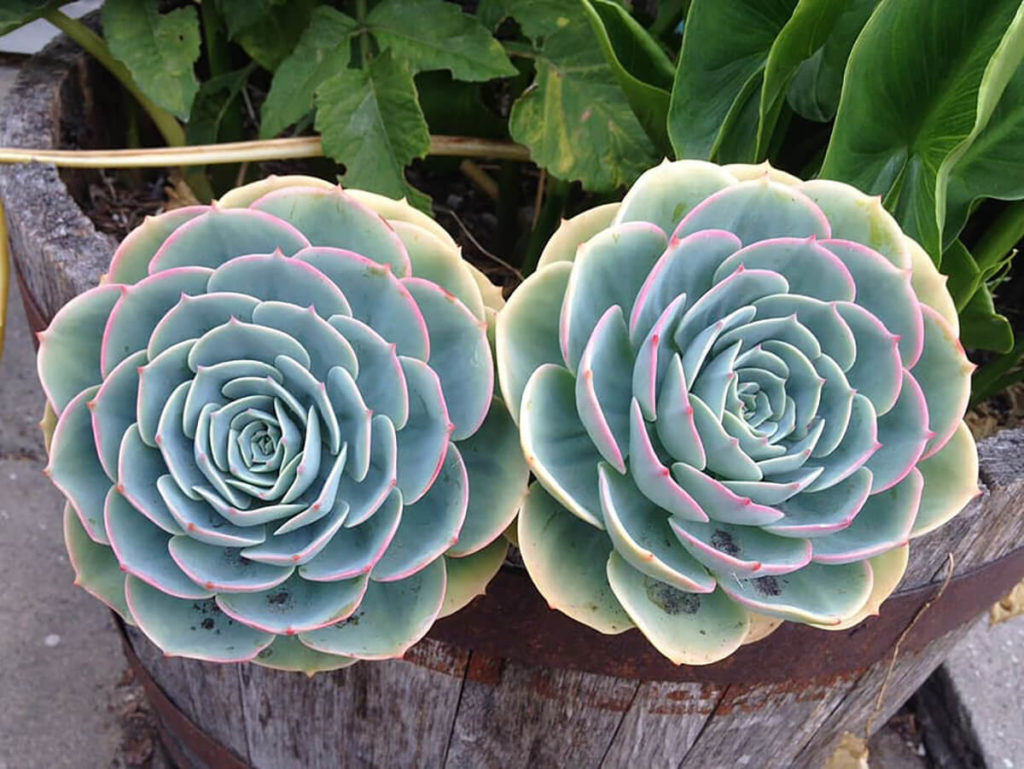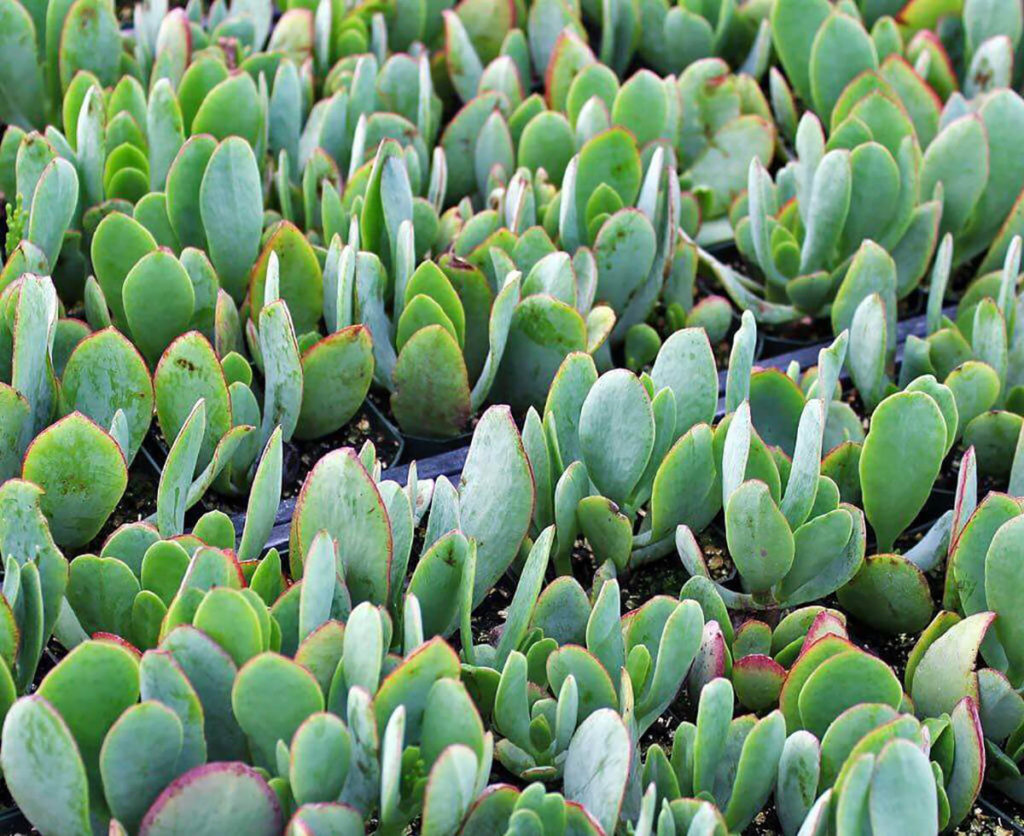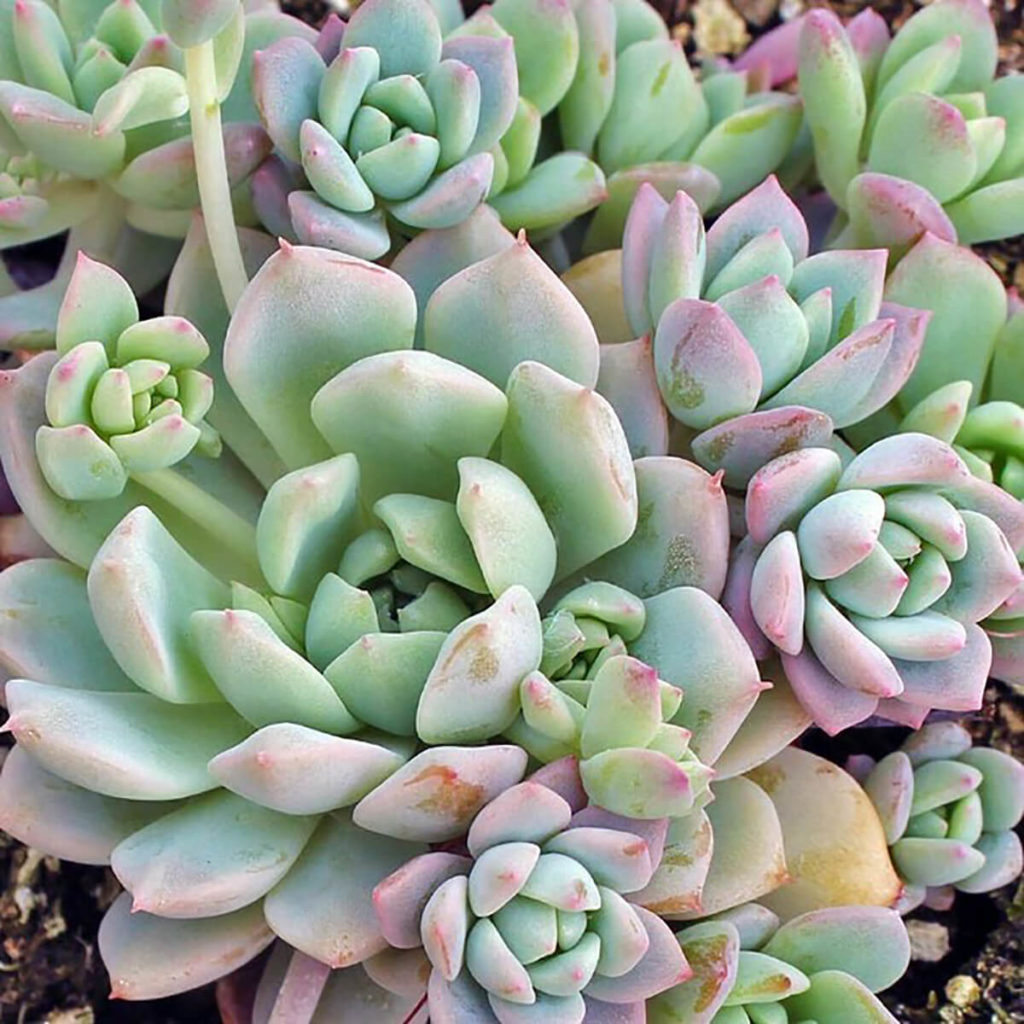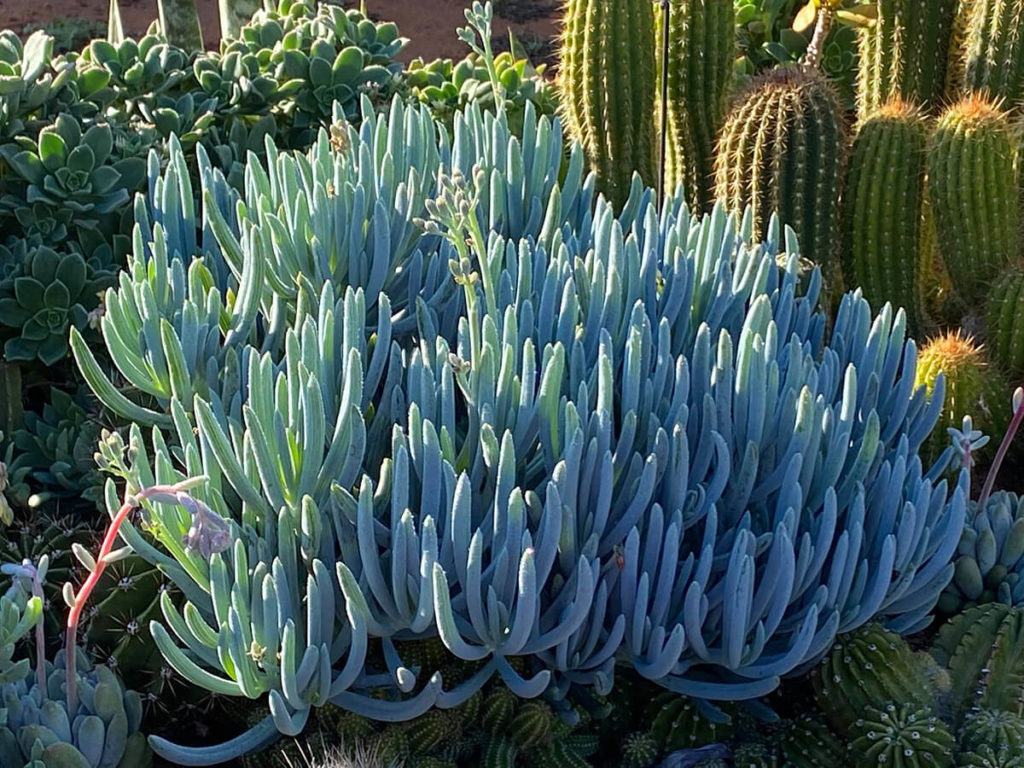One of the many reasons we love succulents is the amazing range of colors they display. Not content to be green plants, there are blue succulents, pink, red, yellow, purple, silver and even white varieties. This array of colors makes any succulent arrangement a beautiful sight. As lovely as a single blue succulent is in, say, a silver container with a coordinating top dressing, think how marvelous it would be to pair it with your favorite pink succulent, or one in white, yellow or maybe brown, (pair a large blue Echeveria with a furry, brown Kalanchoe tomentosa Chocolate Soldier for a fabulous combo)! Let’s take look at my top 20 blue succulent varieties.
My Favorite Blue Succulent Varieties
In this Post We'll Cover:
- My Favorite Blue Succulent Varieties
- Echeveria elegans
- Sedum dasyphyllum
- Echeveria ‘Atlantis’
- Aloe brevifolia – Short-Leaved Aloe
- Echeveria imbricata
- Crassula arborescens ‘Blue Hale’
- Echeveria prolifica
- Agave ‘Blue Flame’
- Senecio mandraliscae “Blue Chalksticks”
- Echeveria ‘Hercules’
- Cereus forbesii monstrose ‘Ming Thing’
- Echeveria ‘Giant Blue’
- Agave potatorum
- Echeveria glauca
- Sedum reflexum ‘Blue Spruce’
- Sedum clavatum
- Echeveria ‘Blue Prince’
- Melocactus azuereus
- Echeveria ‘Orion’
- Sedeveria ‘Blue Burrito’

There are some amazing blue succulent varieties that are quite rare and wildly expensive. They did not make this list. I don’t want to highlight varieties that only a very few can access or afford. Each of these varieties is readily available. Please note: most blue succulents need a great deal of sun to show their best colors. The anthocyaninAnthocyanin (An-tho-SY-an-in) is a blue, red or violet pigme... (protective pigment) responsible for the blue color is created to protect the plant from damage due to the sun’s rays. When grown indoors or in the shade, less blue pigment is produced by the plant, so it reverts to its green appearance.
Another protective strategy most blue succulents have in common is epicuticular waxEpicuticular wax (Ep-i-cyoo-TI-cyoo-lar wax) is a natural, .... You’ll find the hazy, glaucousGlaucous (GLAH-cuss) leaves have the appearance of the whiti... farinaFarina is a term for a very fine flour. Used with succulents... More on most blue succulents. Don’t try to wipe it away. It has a number of benefits for the plant and it takes a loooong time to grow back. Consider the waxy film part of these plants’ unique charm!
{Please note, some links in this post may be affiliate links to sites that pay me a small commission if you click on the link and make a purchase. This commission is at absolutely no cost to you. I only recommend products and companies that I have worked with and truly love! ~Kat}
Most blue succulents are quite pale in their coloring. Definitely pastels, especially with the epicuticular wax. Beware of bright or dark blue succulents for sale, especially of seeds for bright or dark blue varieties. These are almost certainly succulent scams that are either painted or Photoshopped to show an unrealistic shade. one of the following photos of the 20 blue succulent varieties I recommend has been retouched! These are true blue! 🙂
Echeveria elegans

One of the best-loved of all succulents is Echeveria elegans. The perfect rosette is mesmerizing and truly elegant. In partial sun, E. elegans is a pale, blue-tinged green. But grown in full sun, it is a truly blue succulent to treasure. Epicuticular wax imparts a delicate sheen that is lovely.
Echeveria elegans thrives in full to partial sun, with its best coloring in full sun. It may also blush a soft pink in the heat of summer. A petite pant, elegans remains just under 3 inches in height, and rosettes are about 3 inches across. This beauty is hardy to zone 10 (30° F / -1° C).
Sedum dasyphyllum

Sedum dasyphyllum is a wonderful groundcover succulent that forms dense mats of smoky blue foliage in the shape of tiny rosettes. It is lovely in rock gardens, where it weaves between large stones, where it can look like a puddle mirroring the sky. In containers, this Sedum tumbles over the edge, softening the look.
Sedum dasyphyllum grows best in full sun. In the heat of the summer, it can blush pink to lavender. This blue succulent tops out at 3-5 inches tall, and is hardy to zone 7 (0° F / -18° C).
Echeveria ‘Atlantis’

Echeveria ‘Atlantis’ is an exquisite blue succulent with pink tips and margins to its broad leaves. While the majority of blue succulents are Echeveria, each that made this list has something special about it. This one is positively gorgeous paired with small, pink succulents like Crassula pellucida variegate ‘Calico Kitten’ or Anacampseros ‘Sunrise’!
Echeveria ‘Atlantis’ thrives in partial or filtered sunshine. The [pink-edged rosettes reach more than 8-inches across! Hardy to zone 10 (30° F / -1° C).
Aloe brevifolia – Short-Leaved Aloe

Aloe brevifola forms tight clusters of compact rosettes, each lined with fierce-looking teeth that are actually gentle to the touch. The thick, wedge-shaped leaves and sharp-looking teeth add a wonderfully edgy appeal to any mixed succulent arrangement. Unlike most blue succulent varieties, brevifolia maintains its blue foliage best in partial sun to filtered shade. Full sun brings out a vivid scarlet flush that is also very pretty.
Aloe brevifolia is a fast grower, creating more and more rosettes, each reaching just 3-5″ tall. It is hardy to zone 10 (30°F / -1°C).
Echeveria imbricata

Isn’t this a positively stunning blue succulent? This extraordinary photo of Echeveria imbricata was taken by Evelyn Mislang in her glorious garden in Victoria, Australia. She shared it in our Facebook group for succulent lovers (have you joined us yet?) I just knew I had to share this beauty with you, and she generously agreed. Thank you, Evelyn! Usually, this Echeveria shows just blue. But, when grown in a lot of sunshine, the outer leaves blush lovely pink. Exquisite!
Echeveria imbricata thrives in partial sun. Gradually acclimate it to full sun for the most color. This beauty reaches 8-inches or more across! Hardy to zone 10 (30°F / -1°C).
Crassula arborescens ‘Blue Hale’

Crassula arborescens ‘Blue Hale’ is a lovely, blue-tinged jade plant with oval leaves that develop scarlet margins in bright sun. The farina fives it a silvery sheen. It forms a handsome, small shrub that reaches over 12 inches in height, and is perfect for mid-sized pots. Small, starry white blooms are formed in spring and summer.
Crassula arborescens ‘Blue Hale’ thrives in a wide range of lighting, from low light indoors to partial sun, and even full sun, so long as it isn’t scorching hot. At maturity, the leaves reach 4 inches long. This beautiful blue succulent is hardy to zone 10 (30°F / -1°C).
Echeveria prolifica

Echeveria prolific is a natural beauty with turquoise blue and green rosettes flushing a rosy pink in bright sun. True to its name, it is very prolific, forming many offsetsSucculent offsets are the baby succulents that form at the b... that cluster together like sweetheart roses. The thick, silvery farina produces a silvery sheen. This variety has never been found “on the wild”. It is considered possible that all the Echeveria prolifica in the world are vegetative offsets, rather than seed grown. This would mean they are all genetically identical to the original specimen bought from a roadside nursery in Mexico, in 1969!
Echeveria prolifica thrives in bright, partial sun. The rosettes reach 3-4 inches across. Hardy to zone 10 (30°F / -1°C).
Agave ‘Blue Flame’

Agave ‘Blue Flame’ is a sculptural beauty that forms blue, flame-shaped rosettes in the landscape. Although the leaves look smooth, they are finely serrated with terminal spines. This graceful blue succulent makes a handsome specimen plant that eventually forms clusters of pupsSucculent pups are the baby succulents that form at the base... around the mother plant. This monocarpic succulent forms huge bloom spokes that tower 15 feet in height to catch the attention of its preferred pollinators.
Agave ‘Blue Flame’ performs best in full sun, but will tolerate part shade quite well. Individual plants reach 2.5 – 3 feet tall, and 3-4 feet wide. It is hardy to zone 10 (30°F / -1°C).
Senecio mandraliscae “Blue Chalksticks”

Senecio mandraliscae is a fun ground cover succulent that forms dense mats of truly blue leaves about 3-4 inches tall. The size, shape and color lead to the common name “blue chalksticks”. Exceptionally tough, this beauty offers wonderful contrast with other succulents, whether in mass plantings in the landscape or in small succulent arrangements.
Senecio mandraliscae needs full sun to thrive and produce its best color, though it does grow well in partial sun, too. Blue chalksticks is hardy to zone 10 (30°F / -1°C).
Echeveria ‘Hercules’

Echeveria ‘Hercules’ is indeed a strong grower, forming rosettes packed with thick, fleshy leaves that are rimmed and tipped with pink. The blue-green color deepens to true blue in lots of sunshine, and it blushes pink in the heat of summer.
Echeveria ‘Hercules is a small blue succulent, topping out under 3 inches, and reaching just 3-4 inches across. But he’s loaded with charm! He thrives in bright, partial sun to full sun, and is hardy to zone 10 (30°F / -1°C).
Cereus forbesii monstrose ‘Ming Thing’

Cereus forbesii monstrose ‘Ming Thing’ is the monstrose form of a blue-green columnar cactus. The irregular knobs, knots and gnarled growth give Ming Thung tremendous charm. Short, cinnamon-colored spines are few, short and sharp, growing from wooly-looking aereoles. This is an easy cactus to handle, and very hard to resist!
Cereus forbesii monstrose ‘Ming Thing’ tolerates lower light than most cactus and can even be happy indoors. Generally, it grows best in partial to indirect sun. In time, it grows over 12 inches tall. Hardy to zone 10 (30°F / -1°C).
Echeveria ‘Giant Blue’

Echeveria ‘Giant Blue’ is a gorgeous, ruffled variety that always reminds me of a beautiful ball gown with prink-trimmed ruffles and flounces. But don’t be misled, ‘Giant Blue’ is as tough and reliable a grower as it is pretty. This dazzler is one of my favorite blue succulents.
Echeveria ‘Blue Giant’ grows 6-8 inches tall and over 8 inches wide. It thrives in bright, partial sun and is hardy to zone 10 (30°F / -1°C).
Agave potatorum

Agave potatorum is a striking, pale blue succulent whose sculptural rosette is formed by broad leaves with short spikes along the margins and chestnut terminal spike. Each spiked leaf makes a lasting impression on the leaves above as it develops. This slow-grower makes a striking specimen plant, with pups forming slowly over several years. The flower spoke towers 20 feet into the sky when this monocarp finally blooms.
Agave potatorum grows best in full sun. It grows slowly to 1-2 feet tall and 2-3 feet wide and is hardy to zone 10 (30°F / -1°C).
Echeveria glauca

Echeveria glauca is a stunning blue succulent with wide rosettes formed by spade-shaped leaves lightly covered with protective farina. E. glauce offsets freely, soon forming a growing colony of baby plants around the mother. The tips of glauca’s leave flare bright pink to red in the heat of the summer sun.
Echeveria glauca is a fast grower, reaching 6-8 inches across. It thrives in partial to full sun and is hardy to zone 9 ( (20°F / -7°C).
Sedum reflexum ‘Blue Spruce’

You may have noticed that blue succulents are overwhelmingly tender, needing protection from first. Sedum reflexum ‘Blue Spruce’ is a super cold-hardy succulent with blue foliage. The needle-like foliage is soft but provides a wonderful texture in mixed succulent arrangements or the garden bed. This is an outstanding ground cover, forming dense mats of blue-green foliage.
Sedum reflexum ‘Blue Spruce’ thrives in full sun, growing just 3-5 inches tall. It is hardy to zone 4 (-30°F / -34°C). It can be buried under snow all winter and emerge from spring’s thaw looking fresh and lovely!
Sedum clavatum

Sedum clavatum is one of my all-time favorite succulents — not just among the blue varieties. The pudgy little rosettes form freely on curving stems that will tumble over the edge of a planter to form a charming hanging succulent. Easy to propagate by leaf, division or stem cuttings, you’ll always have plenty of S. clavatum to use in mixed arrangements or a wide array of succulent crafts.
Sedum clavatum grows best in full to partial sun. It can grow up to 6-8 inches tall but prefers to sprawl and trail. The rosettes are typically 1 – 2 inches across. Hardy to zone 10 (30°F / -1°C).
Echeveria ‘Blue Prince’

Echeveria ‘Blue Prince’ is a handsome blue succulent whose leaves flush pink in the bright, summer sun. A thick layer of farina lends a silvery sheen to the blue rosettes. Do not allow water to collect and just sit on the leaves, and this beauty will remain healthy and happy in mixed arrangements or in the mild winter gardens bed. Susan Gary shared this pic of her beautiful Prince in our Facebook group and kindly allowed me to share it here. Thanks, Susan!
Echeveria ‘Blue Prince’ tops out at 3-5 inches high, while rosettes reach 5-6 inches across. It thrives in bright, partial sun and is hardy to zone 10 (30°F / -1°C).
Melocactus azuereus

Melocactus azureus is a striking spherical cactus with 9-10 ribs, each sporting many fuzzy white aereoles, bristling with amber and cinnamon-colored spines. As it matures, this cactus develops a cephalium, or a brightly colored structure at the top of certain cacti. The cephalium is wooly or bristly in texture and gives these cacti the common name “Turk’s cap”. This unique structure produces the flowers of these cacti.
Melocactus azureus thrives in full sun, where it can grow up to 12 inches tall and 9 inches wide. This blue succulent is hardy to zone 10 (30°F / -1°C), but looks and grows best when protected from temps below 50°F (10°C).
Echeveria ‘Orion’

Echeveria ‘Orion’ is a wonderful, silvery-blue succulent with broad leaves heavily coated in waxy farina, and edged and tipped in scarlet. This lovely shot was shared by Des Shog-oy Chalanen in our Facebook group. She hosts a wonderful Youtube channel all about succulents and their care. Check out her information at:
The Succulent Therapy Ph.
Echeveria ‘Orion’ thrives in bright, partial sun. Low-growing, the rosettes top out below 3 inches but reach 5-6 inches across. ‘Orion’ is hardy to zone 10 (30°F / -1°C).
Sedeveria ‘Blue Burrito’

Sedeveria ‘Blue Burrito’ is the hybrid offspring of Echeveria peacockii and Sedum moriganianum ‘Burrito’. The soft turquoise blue leaves blush to pink at the tips. The pink coloring becomes more pronounced with age. This colorful succulent grows upwards, with the rosette continuing to elongate along the stem.
Sedeveria ‘Blue Burrito’ thrives in bright, partial sun and can grow 9-12 inches tall, and up to 6 inches across. Beautiful in the mild winter garden bed, it need a substantial-sized pot if it is allowed to grow to its full size. This blue succulent is hardy to zone 10 (30°F / -1°C).

Blue is the hardest color to come by in the garden, making blue-flowering plants a premium. But these blue succulents flash their colors all year round, instead of just a few weeks. And so many glorious shades of blue! Best of all, these are varieties you can find a grow. A few of these, you’ll likely be able to pick up at a local nursery or big box store. For more variety (and better quality) I recommend specialty nurseries or online. Leaf & Clay is an excellent quality succulent vendor and they carry many of these blue beauties. But for the incredible selection and quality, Mountain Crest Gardens is my go-to. Check out their current stock of blue succulents for even more options than my top faves!
Will you be adding any of these charmers to your collection? Which is your favorite, or did I miss one you think deserves inclusion? I would love to learn! Please take a moment to leave me a comment and I will get right back to you!
’til next time,
P.S. For more information on succulent design, care and crafts, please subscribe! I’ll send you my FREE e-course, 7 Steps to Succulent Success! Thanks!
P.P.S. Why not join my Facebook Group for succulent lovers? We talk about succulent care, propagation, succulent identification, and design. It’s a warm and welcoming group that would love to meet you!
P.P.S. Why not join my Facebook Group for succulent-lovers? We talk succulent care, propagation, identification and design. It’s a warm and welcoming group that would love to meet you!




